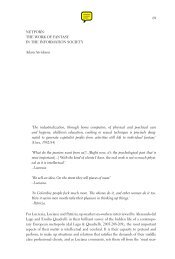Nakamura, Digitizing Race, Introduction, chapter 5, Epilogue
Nakamura, Digitizing Race, Introduction, chapter 5, Epilogue
Nakamura, Digitizing Race, Introduction, chapter 5, Epilogue
Create successful ePaper yourself
Turn your PDF publications into a flip-book with our unique Google optimized e-Paper software.
206 <strong>Epilogue</strong><br />
from this strict industrial norm simply does not work within the program<br />
owing to the file protocols of Instant Messenger, protocols that are immutably<br />
exacting and resistant to modification owing to technological lock-in and<br />
are the direct result of a mature Internet economy and broad user base. Any<br />
change to this platform for communication would require the cooperation<br />
and blessing of several different media conglomerates at this point. The<br />
changes that are possible using the culture-jamming or hacking model of<br />
new media resistance and critique are necessarily constrained and limited<br />
by the form or “system” that enables them. The continuing monetization of<br />
the Internet’s forms and technological apparatuses practically guarantees<br />
that this issue will remain a thorny one.<br />
The cases that I examine in this volume exemplify the efforts of previously<br />
new and previously unexpressive groups of users who are using the<br />
Internet to actively visualize themselves despite and within these constraints,<br />
their differing races, their complicated genders, their generative<br />
and bereft bodies. Yet at the same time, they are performing this cultural<br />
work while living in a post-neoliberal age in which race “doesn’t matter”;<br />
and it has become profoundly unfashionable to be one thing or another,<br />
and actively dangerous to signify race or ethnicity in the public sphere. The<br />
American judiciary system is leaning away from protecting citizens who are<br />
victimized on the basis of race; however, this trend merely reflects, rather<br />
than drives, the culture’s profound disenchantment with antiracist discourse<br />
altogether. As the Yale legal scholar Kenji Yoshino writes: “Americans are<br />
already sick to death of identity politics; the courts are merely following<br />
suit.” 8 While surveys of Internet usage work to reify the notion of racial<br />
groups as traditionally conceived—fast or furious, slow or tepid, as far as<br />
they are concerned every single person who can pick up a phone or boot up<br />
a computer belongs to a group called “Asian American,” “African American,”<br />
“Hispanic,” or “white”—Web sites like alllooksame.com work to<br />
remind users that these categories are national, quasi-biological, visual, political,<br />
and above all unanchored in facticity and intensely subjective. While<br />
these usage or “penetration” surveys are vitally important objects of study<br />
by both humanists and social scientists because they are often used to inform<br />
public policy regarding education and computer access, they are only part of<br />
the story. Though Internet use by racial minorities is indeed increasing, this<br />
is not in itself reason to be optimistic about the medium’s ability to enfranchise<br />
minorities in a realm of friction-free digital production and self-expression.<br />
In the true spirit of neoliberalism, being permitted to exist is not the same<br />
as equal representation. Digital visual capital is a commodity that is not





